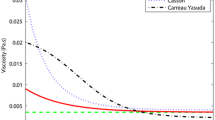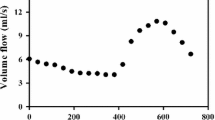Abstract
The integration of phase-contrast magnetic resonance images (PC-MRI) and computational fluid dynamics (CFD) is a way to obtain detailed information of patient-specific hemodynamics. This study proposes a novel strategy for imposing a pressure condition on the outlet boundary (called the outlet pressure) in CFD to minimize velocity differences between the PC-MRI measurement and the CFD simulation, and to investigate the effects of outlet pressure on the numerical solution. The investigation involved ten patient-specific aneurysms reconstructed from a digital subtraction angiography image, specifically on aneurysms located at the bifurcation region. To evaluate the effects of imposing the outlet pressure, three different approaches were used, namely: a pressure-fixed (P-fixed) approach; a flow rate control (Q-control) approach; and a velocity-field-optimized (V-optimized) approach. Numerical investigations show that the highest reduction in velocity difference always occurs in the V-optimized approach, where the mean of velocity difference (normalized by inlet velocity) is 19.3%. Additionally, the highest velocity differences appear near to the wall and vessel bifurcation for 60% of the patients, resulting in differences in wall shear stress. These findings provide a new methodology for PC-MRI integrated CFD simulation and are useful for understanding the evaluation of velocity difference between the PC-MRI and CFD.











Similar content being viewed by others
References
Benim AC, Nahavandi A, Assmann A, Schubert D, Feindt P, Suh SH (2011) Simulation of blood flow in human aorta with emphasis on outlet boundary conditions. Appl Math Model 35:3175–3188
Bokov P, Flaud P, Bensalah A, Fullana JM, Rossi M (2013) Implementing boundary conditions in simulations of arterial flows. J Biomech Eng 135:111004
Boussel L, Rayz V, Martin A, Bolton GA, Lawton MT, Higashida R, Smith WS, Young WL, Saloner D (2009) Phase contrast MRI measurements in intra-cranial aneurysms in vivo of flow patterns, velocity fields and wall shear stress: a comparison with CFD. Magn Reson Med 61:409–417
Castro MA, Putman CM, Sheridan MJ, Cebral JR (2009) Hemodynamic patterns of anterior communicating artery aneurysms: a possible association with rupture. Am J Neuroradiol 30:297–302
Cebral JR, Castro M, Burgess J, Pergolizzi R, Sheridan M, Putman CM (2005) Characterization of cerebral aneurysms for assessing risk of rupture by using patient-specific computational hemodynamics models. Am J Neuroradiol 26:2550–2559
Cebral JR, Xinjie D, Bong JC, Christopher P, Khaled A, Anne R (2015) Wall mechanical properties and hemodynamics of unrupture intracranial aneurysms. Am J Neuroradiol 36(9):1695–1703
Chitanvis SM, Hademenos G, Powers WJ (1995) Hemodynamic assessment of the development and rupture of intracranial aneurysms using computer simulation. Neurol Res 17:426–434
D’Elia M, Perego M, Veneziani A (2012) A variational data assimilation procedure for the incompressible Navier-Stokes equations in hemodynamics. J Sci Comput 52:340–359
D’Elia M, Veneziani A (2013) Uncertainty quantification for data assimilation in a steady incompressible navier-stokes problem. ESAIM: MA2AN 47:1037–1057
Danturthi RS, Partridge LD, Turitto VT (1997) Hemodynamics of intracranial aneurysms: Flow simulation studies. Biomed Eng Conf Proceeding pp 224–227
Ferguson GG (1972) Physical factors in the initiation, growth, and rupture of human intracranial saccular aneurysm. J Neurosurg 37:667–677
Funamoto K, Hayase T, Shirai A, Saijo Y, Yambe T (2005) Fundamental study of ultrasonic-measurement-integrated simulation of real blood flow in the aorta. Ann Biomed Eng 33:415–428
Funamoto K, Hayase T (2013) Reproduction of pressure field in ultrasonic-measurement-integrated simulation of blood flow. Int J Numer Math Biomed Eng 29:726–740
Hoi Y, Meng H, Woodward SH, Bendok Bernard R, Hanel RA, Guterman LR, Hopkins LN (2004) Effects of arterial geometry on aneurysm growth: three-dimensional computational fluid dynamics study. J Neurosurg 101:676–681
Humphrey JD, Canham PB (2000) Structure, mechanical properties, and mechanics of intracranial aneurysms. J Elast 61:49–81
Ingebrigtsen T, Morgan MK, Faulder K, Sparr T, Schirmer H (2004) Bifurcation geometry and the presence of cerebral artery aneurysms. J Neurosurg 101:108–113
Liu X, Gao Z, Xiong H, Ghista D, Ren L, Zhang H, Wu W, Huang W, Hau WK (2016) Three-dimensional hemodynamics analysis of the circle of Willis in the patient-specific nonintegral arterial structures. Biomech Model Mechanobiol 15:1439–1456
Marshall I, Zhao SZ, Papathanasoppilou P, Hoskins P, Xu XY (2004) MRI and CFD studies of pulsatile flow in healthy and stenosed carotid bifurcation models. J Biomech 37:679–687
Marzo A, Singh P, Larrabide I, Radaelli A, Coley S, Gwilliam M, Wilkinson ID, Lawford P, Reymond P, Patel U, Frangi A, Hose DR (2011) Computational hemodynamics in cerebral aneurysms: the effects of modeled versus measured boundary conditions. Ann Biomed Eng 39:884–896
Moore JA, Steinman DA, Holdsworth DW, Ethier CR (1999) Accuracy of computational hemodynamics in complex arterial geometries reconstructed from phase contrast MRI. Ann Biomed Eng 27:32–41
Omodaka S, Inoue T, Funamoto K, Sugiyama S, Shimizu H, Hayase T, Takahashi A, Tominaga T (2012) Influence of surface model extraction parameter on computational fluid dynamics modeling of cerebral aneurysms. J Biomech 45:2355–2361
Oshima M, Kobayashi T, Takagi K (2002) Biosimulation and visualization effect of cerebrovascular geometry on hemodynamics. Ann NY Acad Sci 972:337–344
Oshima M, Torii R, Kobayashi T, Taniguchi N, Takagi K (2001) Finite element simulation of blood flow in the cerebral artery. Comput Methods Appl Mech Eng 191:661–671
Paal G, Ugron A, Szikora I, Bojtar I (2007) Flow in simplified and real models of intracranial aneurysms. Int J Heat Fluid Flow 28:653–664
Papathanasopoulou P, Zhao SZ, Kohler U, Robertson MB, Long Q, Hoskins P, Xu XY, Marshall I (2003) MRI measurement of time-resolved wall shear stress vectors in a carotid bifurcation model, and comparison with CFD predictions. J Magn Reson Imaging 17:153–162
Paul JB (1992) A method for registration of 3D shapes. IEEE Trans Pattern Anal Mach Intell 14:239–256
Reorowicz P, Obidowski D, Klosinski P, Szubert W, Stefanczyk L, Jozwik K (2014) Numerical simulations of the blood flow in the patient-specific arterial cerebral circle region. J Biomech 47(7):1642–1651
Steinman DA (2002) Image-based computational fluid dynamics modeling in realistic arterial geometries. Ann Biomed Eng 30:483–497
Steinman DA, Milner JS, Norley CJ, Lownie SP, Holdsworth DW (2003) Image-based computational simulation of flow dynamics in a giant intracranial aneurysm. Am J Neuroradiol 24:559–566
Steiger HJ (1990) Pathophysiology of development and rupture of cerebral aneurysms. Acta Neurochir Suppl (Wien) 48:1–57
Ugron A, Paal G (2014) On the boundary conditions of cerebral aneurysm simulations. Period Polytech Mech Eng 58:37–45
Zoran S, Bradley DA, Julio G, Kelly BJ, Michael M (2014) 4D flow imaging with MRI. Cardiovasc Diagn Ther 4:173–192
Acknowledgements
This work was supported in part by the Japan Society for the Promotion of Science Grants-in-Aid for Scientific Research (No. 23650261) and the Ministry of Education, Culture, Sports, Science and Technology project, “Creating Hybrid Organs of the Future” at Osaka University.
Author information
Authors and Affiliations
Corresponding authors
Rights and permissions
About this article
Cite this article
Mohd Adib, M.A.H., Ii, S., Watanabe, Y. et al. Minimizing the blood velocity differences between phase-contrast magnetic resonance imaging and computational fluid dynamics simulation in cerebral arteries and aneurysms. Med Biol Eng Comput 55, 1605–1619 (2017). https://doi.org/10.1007/s11517-017-1617-y
Received:
Accepted:
Published:
Issue Date:
DOI: https://doi.org/10.1007/s11517-017-1617-y




